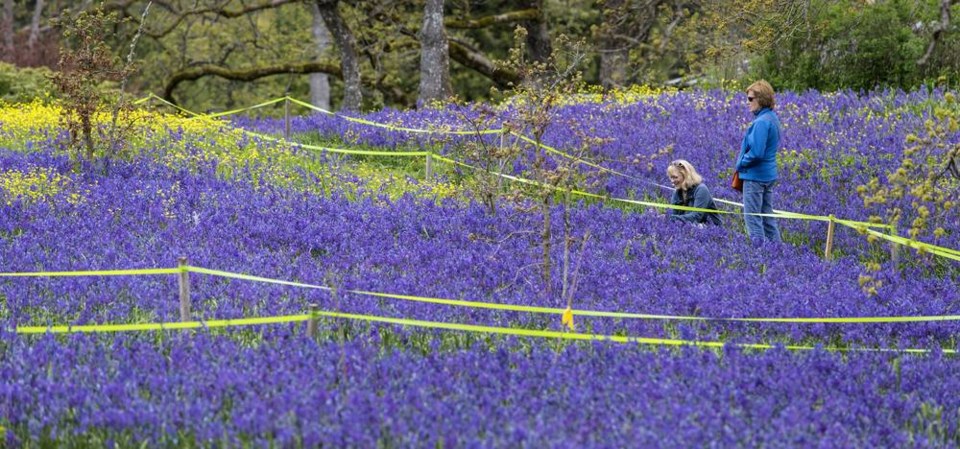“When Chief Factor James Douglas saw six square miles of open camas meadows surrounding Victoria (then called Camosack), the search for the site of the new Hudson’s Bay Company fort was over,” begins local writer Janis Ringuette’s Camas Country, an account of that early history of Beacon Hill Park. “The verdant grasslands were a spectacular sight in spring…. Native grasses and clover grew tall and lush. Colourful blue camas mixed with golden paintbrush, white fawn lilies, chocolate lilies, lupins, buttercups and violets.”
Douglas was looking for land that could be easily ploughed and planted to feed the men working at the fort-to-be. The camas meadows where Beacon Hill now stands were exactly what he was seeking along this otherwise wild, rocky and forested stretch of coast.
He was so taken with the springtime scene, Ringuette writes, he later gushed in a letter to his friend James Hargrave: “The place itself appears a perfect ‘Eden’ in the midst of the dreary wilderness of the North.”
Ringuette’s history of the park can be read at beaconhillparkhistory.org.
The camas fields of 1842 may have prompted Douglas to establish Fort Victoria on these shores, but the Lekwungen people already had a long history of managing those very same meadows for food. Blue camas, or Camassia quamash for those who speak in science code, was an important food source for First Nations across the Pacific Northwest.
Found from southern B.C. to California, the lily-like plant with spikes of striking bluey-purple-starred flowers grows in meadows and grassy bluffs here on the coast and also in upland valleys and prairies of the Columbia River Plateau of the Interior.
When steamed, the nutritious onion-like bulbs of the blue camas plant develop a sweet, tasty flavour. They can then be eaten whole or dried and pounded into flour.
David Thompson’s journals tell of how he, his wife and their companions survived on camas during a long, cold winter in the Columbia River Valley in the early 1800s.
The journals of the Lewis and Clark Expedition also mention the unusual-to-Europeans food. When the expedition finally crossed the Rocky Mountains in September 1805, the Nez Perce peoples they encountered fed them camas root. The starving men ate themselves sick. Clark reported in the journals on Sept. 21: “I am verry Sick to day and puke which relive me.” Lewis and two others also succumbed.
The First Nations narrative covers a much longer period. Practices documented at the time, historic records and oral histories indicate camas was harvested with wooden digging sticks during the summer after the flowers had faded and that seed capsules, dried stalks, and uprooted immature bulbs were often replanted.
They also tell of how, in places such as southern Vancouver Island, camas meadows were intentionally burned to suppress competing plants and to aerate and fertilize the soil.
Although it’s unclear when such harvesting and stewardship practices first became established, some research suggests that the First Peoples in the Pacific Northwest have been eating camas for more than 8,000 years and frequently traded it over hundreds of kilometres.
One recent study published by the Royal Society confirms the practices in Pend Oreille Valley of northeastern Washington back to 3,500 years ago. When researchers from Washington State University at Pullman analyzed the available archeological, palaeoclimatological and botanical data, they found evidence that two main camas harvest patterns in the area alternated at roughly 500-year intervals, beginning some 4,000 years ago.
From 3,500 to 3,000 years ago, it appears the region’s inhabitants selectively harvested bulbs of mature plants and likely replanted immature bulbs and seed capsules. Then, 2,500-2,000 years ago, bulbs of all ages and maturities were collected — a gathering free-for-all that can deplete local resources, no matter what is being harvested or who does the harvesting.
However, by 1,000 years ago, the evidence shows people returning to harvesting primarily mature bulbs. The pattern continued through to contact with Europeans in the 18th and 19th centuries and likely is the basis for the oral histories and contemporary accounts that have been documented.
Enter James Douglas of the Hudson’s Bay Company, aboard a ship. “I was … delighted in ranging over fields knee deep in clover, tall grasses and ferns reaching above our heads, at these unequivocal proofs of fertility,” he wrote to Hargrave.
He camas’ed. He saw. He colonized.
The rest, as they say, is (colonial) history.



